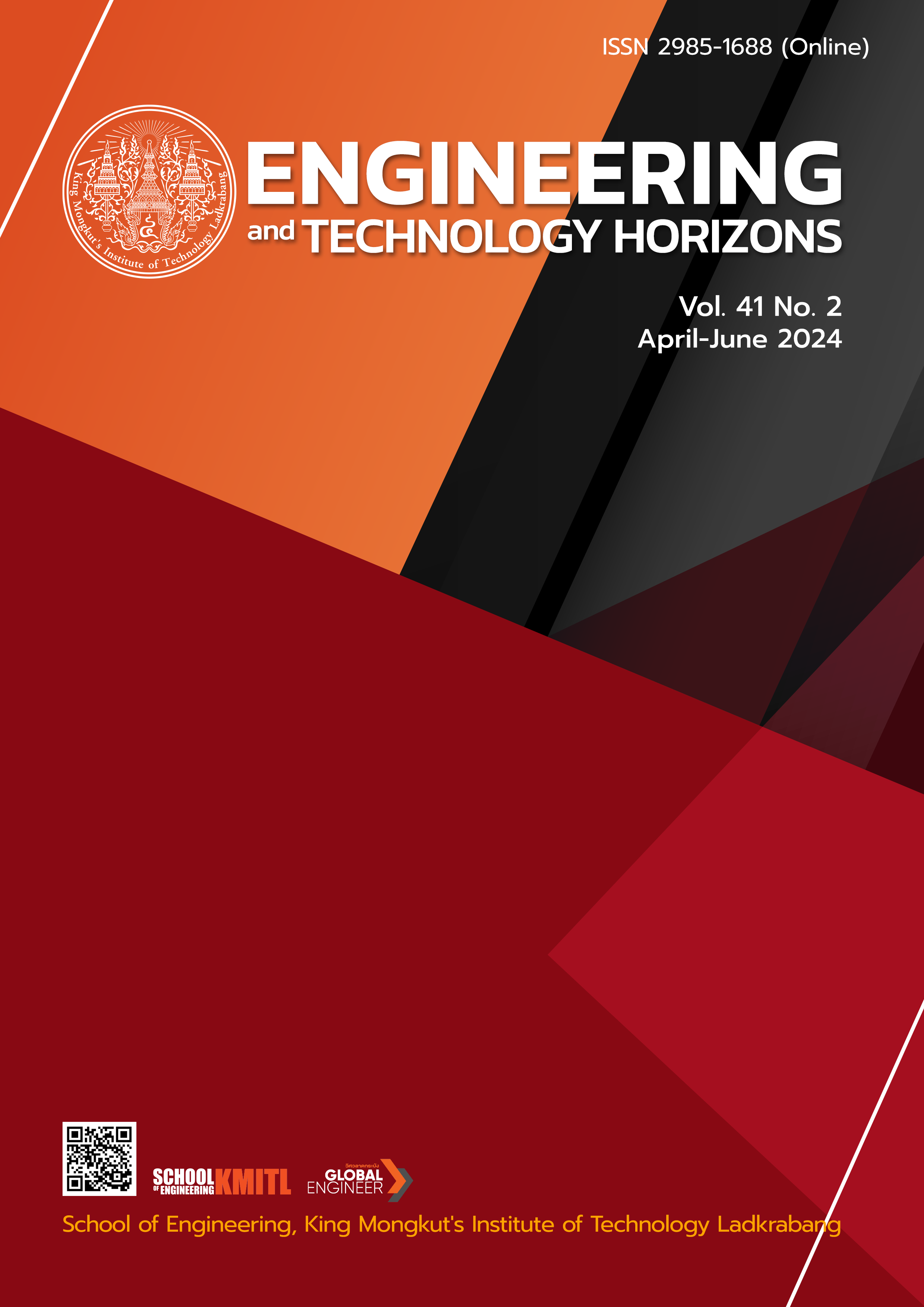การพัฒนาวิธีวิวัฒนาการโดยใช้ผลต่างสำหรับปัญหาการจัดสมดุลสายการประกอบแบบอย่างง่าย ประเภทที่ 1
DOI:
https://doi.org/10.55003/ETH.410208คำสำคัญ:
การจัดสมดุลสายการประกอบแบบอย่างง่าย, วิธีวิวัฒนาการโดยใช้ผลต่าง, วิธีฮิวริสติกบทคัดย่อ
ปัญหาการจัดสมดุลสายการประกอบแบบอย่างง่าย ประเภทที่ 1 (Simple Assembly Line Balancing Problem Type 1: SALBP-1) เป็นปัญหาที่สำคัญในอุตสาหกรรมที่นิยมใช้เป็นจำนวนมากเนื่องจากจัดกระบวนการผลิตได้ง่ายและมีประสิทธิภาพ งานวิจัยนี้จึงได้ทำการพัฒนาวิธีวิวัฒนาการโดยใช้ผลต่าง (Development of Differential Evolution Algorithm: DDE) โดยใช้ลำดับงานที่มองย้อนกลับ (Backward) เข้ามาช่วยในการจัดกระบวนการผลิตเพื่อหาจำนวนสถานีงานทีต่ำที่สุด และวัดประสิทธิภาพของวิธีการโดยการเปรียบเทียบกับวิธีฮิวริสติก ได้แก่ การจัดงานที่ใช้เวลามากที่สุด (Longest Operation Time: LOT), การจัดงานที่มีงานตามหลังมากที่สุด (Most Following Tasks: MFT), การจัดงานที่มีค่าน้ำหนักมากที่สุด (Ranked Positional Weight: RPW), การจัดงานที่ใช้เวลาสั้นที่สุด (Shortest Operation Time: SOT), การจัดงานที่มีงานตามหลังน้อยที่สุด (Fewest Following Tasks: FFT), วิธีอาณานิคมมด (Ant Colony Optimization: ACO), วิธีวิวัฒนาการโดยใช้ผลต่าง (Differential Evolution: DE) และวิธีเชิงพันธุกรรมภูมิคุ้มกัน (Immune Genetic Algorithm: IGA) พบว่าวิธี DDE สามารถค้นหาคำตอบได้ดีกว่าวิธี LOT, วิธี MFT, วิธี RPW, วิธี SOT, วิธี FFT และได้คำตอบที่เท่ากันในทุกปัญหาเมื่อเปรียบเทียบกับวิธี ACO, วิธี DE และวิธี IGA แต่วิธี DDE ใช้เวลาในการค้นหาคำตอบที่รวดเร็วกว่า
References
K. Chantarasamai and O. U. Lasunon, “Modified Differential Evolution Algorithm for U-Shaped Assembly Line Balancing Type 2,” International Journal of Intelligent Engineering & Systems, vol. 14, no. 4, pp. 452–462, 2021, doi: 10.22266/ijies2021.0831.39.
J. Dou, J. Li and Q. Lv, “A hybrid particle swarm algorithm for assembly line balancing problem of type 1,” in 2011 IEEE International Conference on Mechatronics and Automation, Beijing, China, 2011, pp. 1664–1669, doi: 10.1109/ICMA.2011.5986373.
M. N. I. Sulaiman, Y. H. Choo and K. E. Chong, “Ant colony optimization with look forward ant in solving assembly line balancing problem,” in 2011 3rd Conference on Data Mining and Optimization (DMO), Putrajaya, Malaysia, 2011, pp. 115–121, doi: 10.1109/DMO.2011.5976514.
Y. guang Zhong and B. Ai, “A modified ant colony optimization algorithm for multi-objective assembly line balancing,” Soft Computing, vol. 21, no. 22, pp. 6881–6894, 2017, doi: 10.1007/s00500-016-2240-9.
A. C. Nearchou and S. L. Omirou, “Assembly Line Balancing Using Differential Evolution Models,” Cybernetics and Systems, vol. 48, no. 5, pp. 436–458, 2017, doi: 10.1080/01969722.2017.1319238.
P. Parawech and R. Pitakaso, “Solving an Assembly Line Balancing Problem by Differential Evolution,” Journal of Industrial Technology Ubon Ratchathani Rajabhat University, vol. 3, no. 6, pp. 13–20, 2013.
P. Parawech, R. Paitakaso and P. Mayachearw, “Solving an Assembly Line Balancing Problem by Differential Evolution: A Case Study of a Garment Factory,” Princess Naradhiwas University Journal, vol. 6, no. 2, pp. 92–104, 2014.
H. Y. Zhang, “An improved immune algorithm for simple assembly line balancing problem of type 1,” Journal of Algorithms & Computational Technology, vol. 11, no. 4, pp. 317–326, 2017, doi: 10.1177/1748301817710924.
H. -y Zhang, “An immune genetic algorithm for simple assembly line balancing problem of type 1,” Assembly Automation, vol. 39, no. 1, pp. 113–123, 2019, doi: 10.1108/AA-08-2017-101.
Z. Li, I. Kucukkoc and Q. Tang, “A comparative study of exact methods for the simple assembly line balancing problem,” Soft Computing, vol. 24, no. 15, pp. 11459–11475, 2020, doi: 10.1007/s00500-019-04609-9.
O. A. Arık, E. Köse and J. Forrest, “Simple assembly line balancing problem of Type 1 with grey demand and grey task durations,” Grey Systems: Theory and Application, vol. 9, no. 4, pp. 401–414, 2019, doi: 10.1108/GS-05-2019-0011.
P. SreSracoo and K. Chantarasamai, “COMSOAL METHOD FOR ASSEMBLY LINE BALANCING To REDUCE IDLE TIME,” Kasem Bundit Engineering Journal, vol. 9, no. 2, pp. 90–104, 2019.
R. Storn and K. Price, “Differential Evolution – A Simple and Efficient Heuristic for Global Optimization over Continuous Spaces,” Journal of Global Optimization, vol. 11, no.4, pp. 341–359, 1997, doi: 10.1023/A:1008202821328.
S. Kaewman, T. Srivarapongse, C. Theeraviriya and G. Jirasirilerd, “Differential Evolution Algorithm for Multilevel Assignment Problem: A Case Study in Chicken Transportation,” Mathematical and Computational Applications, vol. 23, no. 4, 2018, Art. no. 55, doi: 10.3390/mca23040055.
R. Kamphukaew, K. Sethanan, T. Jamrus and H. K. Wang, “Differential evolution algorithms with local search for the multi-products capacitated vehicle routing problem with time windows: A case study of the ice industry,” Engineering and Applied Science Research, vol. 45, no. 4, pp. 273–281, 2018, doi: 10.14456/easr.2018.37.
R. Akararungruangkul and S. Kaewman, “Modified Differential Evolution Algorithm Solving the Special Case of Location Routing Problem,” Mathematical and Computational Applications, vol. 23, no. 3, 2018, Art. no. 34, doi: 10.3390/mca23030034.
Benchmark Data Sets by Scholl (1993), Data Line Balancing, 2022. [Online]. Available: https://assembly-line-balancing.de/salbp/benchmark-data-sets-1993.
Downloads
เผยแพร่แล้ว
How to Cite
ฉบับ
บท
License
Copyright (c) 2024 คณะวิศวกรรมศาสตร์ สถาบันเทคโนโลยีพระจอมเกล้าเจ้าคุณทหาร

This work is licensed under a Creative Commons Attribution-NonCommercial-NoDerivatives 4.0 International License.
บทความที่ได้รับการตีพิมพ์เป็นลิขสิทธิ์ของคณะวิศวกรรมศาสตร์ สถาบันเทคโนโลยีพระจอมเกล้าเจ้าคุณทหารลาดกระบัง
ข้อความที่ปรากฏในบทความแต่ละเรื่องในวารสารวิชาการเล่มนี้เป็นความคิดเห็นส่วนตัวของผู้เขียนแต่ละท่านไม่เกี่ยวข้องกับสถาบันเทคโนโลยีพระจอมเกล้าเจ้าคุณทหารลาดกระบัง และคณาจารย์ท่านอื่นๆในสถาบันฯ แต่อย่างใด ความรับผิดชอบองค์ประกอบทั้งหมดของบทความแต่ละเรื่องเป็นของผู้เขียนแต่ละท่าน หากมีความผิดพลาดใดๆ ผู้เขียนแต่ละท่านจะรับผิดชอบบทความของตนเองแต่ผู้เดียว






